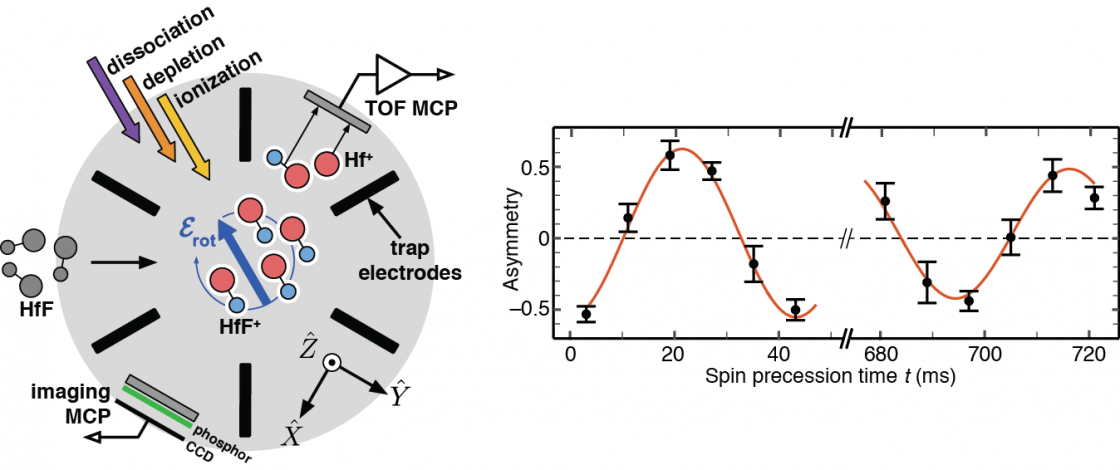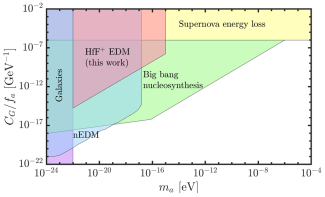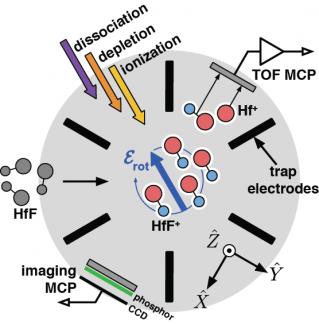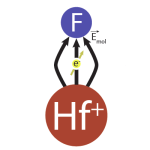
Back: Eric, Maddie, Jun, Xin, Vandy. Middle: Tanner, Noah, Antonio, Yuval. Front: Krista, Sun Yool, Tanya, Kia Boon.
An electron EDM search using trapped molecular ions

Caption for image. Lorem ipsum dolor sit amet, consectetur adipiscing elit. Nullam sit amet porttitor lectus. Maecenas volutpat dolor tincidunt, congue sapien et, porta dolor.
The JILA electron EDM experiment (eEDM) uses the unique approach of performing a high-precision measurement on HfF+ molecular ions trapped in an rf trap. A low-lying, metastable 3Δ1 state in HfF+ with a 2.1(1) s radiative lifetime offers enhanced eEDM sensitivity, rejection of systematic errors, and measurement coherence times of up to 3 s. Additionally, the ability to explicitly measure phase at early and late spin precession times provides suppression of systematic errors common to beamline experiments.
Our recently-concluded second-generation experiment has placed a limit on the eEDM of |de| < 4.1 x 10-30 e cm. The third-generation experiment will use ThF+, which has a larger internal effective electric field and a 3Δ1 ground state.
Selected Paper Abstracts
Experimental constraint on axion-like particle coupling over seven orders of magnitude in mass
We use our recent electric dipole moment (EDM) measurement data to constrain the possibility that the HfF+ EDM oscillates in time due to interactions with candidate dark matter axion-like particles (ALPs). We employ a Bayesian analysis method which accounts for both the look-elsewhere effect and the uncertainties associated with stochastic density fluctuations in the ALP field. We find no evidence of an oscillating EDM over a range spanning from 27 nHz to 400 mHz, and we use this result to constrain the ALP-gluon coupling over the mass range 10−22−10−15 eV. This is the first laboratory constraint on the ALP-gluon coupling in the 10−17−10−15 eV range, and the first laboratory constraint to properly account for the stochastic nature of the ALP field.
Phys. Rev. Lett. 126, 171301 (2021). arXiv
Control and imaging of molecular quantum states with second-scale coherence
Cold molecules provide an excellent platform for quantum information, cold chemistry, and precision measurement. Certain molecules have enhanced sensitivity to beyond Standard Model physics, such as the electron's electric dipole moment (eEDM). Molecular ions are easily trappable and are therefore particularly attractive for precision measurements where sensitivity scales with interrogation time. Here, we demonstrate a spin precession measurement with second-scale coherence at the quantum projection noise (QPN) limit with hundreds of trapped molecular ions, chosen for their sensitivity to the eEDM rather than their amenability to state control and readout. Orientation-resolved resonant photodissociation allows us to simultaneously measure two quantum states with opposite eEDM sensitivity, reaching the QPN limit and fully exploiting the high count rate and long coherence.
Phys. Rev. Lett. 124, 053201 (2020). arXiv
A precision measurement of the electron’s electric dipole moment using trapped molecular ions
We describe the first precision measurement of the electron’s electric dipole moment (eEDM, de) using trapped molecular ions, demonstrating the application of spin interrogation times over 700 ms to achieve high sensitivity and stringent rejection of systematic errors. Through electron spin resonance spectroscopy on 180Hf19F+ in its metastable 3∆1 electronic state, we obtain de = (0.9 ± 7.7stat ± 1.7syst ) × 10−29 e cm, resulting in an upper bound of |de| < 1.3 × 10−28 e cm (90% confidence). Our result provides independent confirmation of the current upper bound of |de| < 9.3 × 10−29 e cm [J. Baron et al., Science 343, 269 (2014)], and offers the potential to improve on this limit in the near future.
Phys. Rev. Lett. 119, 153001 (2017). arXiv
Precision Spectroscopy of Polarized Molecules in an Ion Trap
Polar molecules are desirable systems for quantum simulations and cold chemistry. Molecular ions are easily trapped, but a bias electric field applied to polarize them tends to accelerate them out of the trap. We present a general solution to this issue by rotating the bias field slowly enough for the molecular polarization axis to follow but rapidly enough for the ions to stay trapped. We demonstrate Ramsey spectroscopy between Stark-Zeeman sublevels in 180Hf19F+ with a coherence time of 100 ms. Frequency shifts arising from well-controlled topological (Berry) phases are used to determine magnetic g-factors. The rotating-bias-field technique may enable using trapped polar molecules for precision measurement and quantum information science, including the search for an electron electric dipole moment.
Science 342, 1220-1222 (2013). arXiv
Broadband velocity modulation spectroscopy of HfF+: Towards a measurement of the electron electric dipole moment
Precision spectroscopy of trapped HfF+ will be used in a search for the permanent electric dipole moment of the electron (eEDM). While this dipole moment has yet to be observed, various extensions to the standard model of particle physics (such as supersymmetry) predict values that are close to the current limit. We present extensive survey spectroscopy of 19 bands covering nearly 5000 cm-1 using both frequency-comb and single-frequency laser velocity-modulation spectroscopy. We obtain high-precision rovibrational constants for eight electronic states including those that will be necessary for state preparation and readout in an actual eEDM experiment.
Chem. Phys. Lett. 546, (2012) 1-11. arXiv
High-resolution spectroscopy on trapped molecular ions in rotating electric fields: A new approach for measuring the electron electric dipole moment
High-resolution molecular spectroscopy is a sensitive probe for violations of fundamental symmetries. Symmetry violation searches often require, or are enhanced by, the application of an electric field to the system under investigation. This typically precludes the study of molecular ions due to their inherent acceleration under these conditions. Circumventing this problem would be of great benefit to the high-resolution molecular spectroscopy community since ions allow for simple trapping and long interrogation times, two desirable qualities for precision measurements. Our proposed solution is to apply an electric field that rotates at radio frequencies. We discuss considerations for experimental design as well as challenges in performing precision spectroscopic measurements in rapidly time-varying electric fields. Ongoing molecular spectroscopy work that could benefit from our approach is summarized. In particular, we detail how spectroscopy on a trapped diatomic molecular ion with a ground or metastable 3Δ1 level could prove to be a sensitive probe for a permanent electron electric dipole moment (eEDM).
J. Mol. Spectrosc. 270 (2011) 1-25. arXiv









